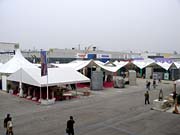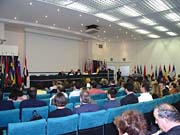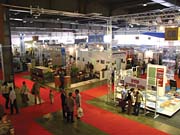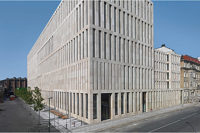
The 39th edition of Marmomacc, the International Natural Stone and Technologies Exhibition is set to take place from October 7 to 10, 2004, in Verona, Italy. With the exhibition completely booked five months in advance and a waiting list of approximately 50 companies, show organizer VeronaFiere is anticipating success.
The 2003 edition of Marmomacc -- in accordance with data certified by the independent German auditor FKM -- attracted 1,386 exhibitors, of which 862 were Italian companies and 524 were from about 50 foreign countries. Statistics also illustrated that the exhibition, which covered a net area of almost 670,000 square feet, drew a total of 56,518 visitors, of which 19,197 were foreigners from 110 different countries.
As an international exhibition, Marmomacc 2004 will provide a setting for business exchanges, commercial contacts and professional training. VeronaFiere -- officially appointed in 1999 as “education provider†for the AIA (American Institute of Architects) and in 2003 for RIBA (Royal Institute of British Architects) -- this year will welcome qualified architects from all over the world to study the characteristics and languages of stone, its applications and potential applications that precisely in Germany are experiencing a period of considerable interest. (To learn more details about this program, please read “AIA Continuing Education Course to take place at Marmomaccâ€).
Marmomacc 2004 will also feature a series of initiatives dedicated to Germany and its new stone architecture. In particular, there will be an exhibition dealing with the art of building with stone, including a selection of works by leading German architects and recent projects in the reconstruction of Berlin.
In 2003, there was growing interest at the fair among operators from elsewhere within the European Union (36.07% of the total), which was up 3.28% compared with 2002, in particular from Belgium, Portugal and Finland. Attendance was also positive from the Middle East and Central Asia (4.77% of the total, an increase of 4.17% compared with the previous edition), while Lebanon was extremely lively; Africa (5.15% of the total) improved by 14.45% over 2002, with significant increases also by Egypt and Zimbabwe. Attendance from East Asia was consolidated (17.94% of the total) as well as from South America (10.5% of the total international operators), as well as from non-EU European countries (22.33% of the total), with an increase of 14.71% in attendance compared with 2002, in particular from Turkey, Russia and Switzerland.
Research also showed that 36.4% of the visitors were producers, 16.1% were distributors/importers representing companies taking part in the ex-hibition, 15.7% were independent distributors/importers, 9.6% were building/construction companies, 8.9% were architects/designers and 13.2% were in a series of sectors directly or indirectly involved in the stone industry, such as insurance, banking, IT services, etc.
In the majority of cases (64 %), those in attendance had already visited Marmomacc in previous years, and almost 50% of those polled intended to attend the 2004 edition. Moreover, 92.1% of those polled expressed high satisfaction for the event, which was up from 86.8% the year before. The reasons for such appreciation include the completeness and range of the event, especially among visitors from North America and the Middle East.
“Verona can rightly be considered -- given visitor and exhibitor data over the last few years -- as the world capital of marble and natural stone,†said Giovanni Mantovani, Director General of VeronaFiere. “If we are to reach the heart of market processes, we need shows and cultural events designed with the final consumer in mind by ensuring direct contact between products and potential users.â€

Honoring German architecture
For almost two decades, Germany has taken on an avant-garde role in the use of stone materials in architecture, said Vincenzo Pavan, the curator of the cultural events at Marmomacc.The new reconstruction of the cities severely damaged during war have helped further confirm the role of Germany as an international workshop for architecture in the decades prior to and following the fall of the Berlin Wall and the reunification of the country. In particular, Berlin -- recognized today as one of the international capitals of contemporary architecture -- is at the heart of the debate over the relationship between traditional building materials and new architectural languages. This debate has far-reaching contradictions and contrasts between the protagonists over numerous topics.
In this context, VeronaFiere is organizing an exhibition entitled, “Germany: the art of building in stone,†which will embrace a selection of the best works in stone implemented by the most important protagonists of contemporary German architecture: Bolles and Wilson, Kollhoff & Timmermannn, Larsen, Pei, etc. A special section of the initiative will be dedicated to several recent projects in the reconstruction of Berlin that are significant in terms of the use of stone materials: Leipziger Platz and Potsdamer Platz-Lenné Dreieck, which are important works of restoration and reconstruction involving several public squares.
VeronaFiere will also organize a presentation on Saturday, October 9th titled “Stone Idioms in New German Architecture,†coordinated by architect Augusto Roman Burelli. The meeting will be attended by historians, critics and exponents of the various approaches taken in German architecture involved in experiences of construction with stone.
Career Award
Because culture and economy are viewed as inseparable elements for VeronaFiere, it set up the International Stone Architecture Award in 1987. This year, a prestigious new award, the Marmomacc Career Award 2004, will be launched. The first recipient will be renowned architect Hans Stimmann of Germany.The International Stone Architecture Award is held every two years, and targets the main interpreters of the most significant architectural experiences in recent times, where stone is the “identity†material that determines the aesthetic values and technical quality of projects. The new award will be linked this year with events at Marmomacc detailing the qualitative use of stone in modern German architecture.
The Consulting Committee, involving well-known experts from both Italy and abroad (Augusto Roman Burelli, Marco Casamonti, Francesco Cellini, Werner Oechslin and Vincenzo Pavan), identified Stimmann -- Senatsbaudirektor of the City of Berlin -- as the key figure in contemporary stone architecture in Germany, and one of the most representative exponents of the “German workshop†highlighted at Marmomacc in the Marble Art Culture section through shows and conventions.
Moreover, the exhibition, which will welcome this year around 1,000 architects from all over the world, last June also received a prestigious preview thanks to the conference “Stone Concepts and Craftsmanship in Constructions†held by Professor Francesco Venezia of the Venice University Institute of Architecture and one of the leading world experts in the use of stone in buildings.
An architect himself, he was born in Lauro (Avellino) in 1944 and is famed for some of his innovative works -- the Gibellina Museum, the Open-Air Theatre in Salemi, the University Library and Law & Economics Centre in Amiens (France), which won the International Stone Architecture Award in 1997, the Material Testing Laboratory at the Faculty of Architecture, Venice & Mestre, etc. -- and also for having lectured in Berlin, Harvard and Lausanne. He analyzed the use of stone over history and terms of its expressive characteristics and wide-ranging application potential.
He particularly emphasised the need for a “workshop of ideas†behind any “building project,†otherwise “stone will not flourish.†“We have to 'think' stone,†he pointed out, “and to do so we need precise rules -- rules of art. Today, we often witness projects lacking true theoretical analysis, with readily imagined consequences. Stone, by its very nature, communicates the idea of 'construction' and in recent years has seen a large-scale revival. It must be viewed as a material that survives time.â€
The conference was part of a project that VeronaFiere has promoted for several years, as highlighted by President Luigi Castelletti, with the aim of “promoting a show that not only lasts for the days of the event as such, but also for the rest of the year.â€
To obtain more information about the upcoming exhibition, visit Marmomacc's Web site at www.marmomacc.com.

Sidebar: AIA Continuing Education Course to take place at Marmomacc
The sixth edition of the Veronafiere's AIA-approved Continuing Education course, co-sponsored with Stone World magazine, will be held Wednesday, October 6 through Saturday, October 9, 2004, during Marmomacc, the world's leading trade fair for the marble and stone industry.The course, “Designing with Natural Stone,†provides a comprehensive overview of architectural stone applications. Architects learn how marble is quarried, treated, cut, selected for specific jobs, and then installed using the latest products and technologies. The course will include field trips to a quarry and stone cutting factories, a tour of Palladian villas, and ample time for a thorough exploration of Marmomacc.
This program has been offered for the past five years and has generated such comments as: “One of the most informative continuing education programs I have attended.†-- John Stephenson, Thompson Ventulette and Stainback & Associates (Atlanta); “I found this a memorable course. The technical content was accurate and excellent.â€-- Louise Addonizio, Perkins and Will (New York); “I thought it was a fantastic program; well worth the time.†-- John Coons, Sasaki Associates (San Francisco).
Architects will earn about 20 AIA/CES learning-unit hours. Many classes will provide HSW credits.
